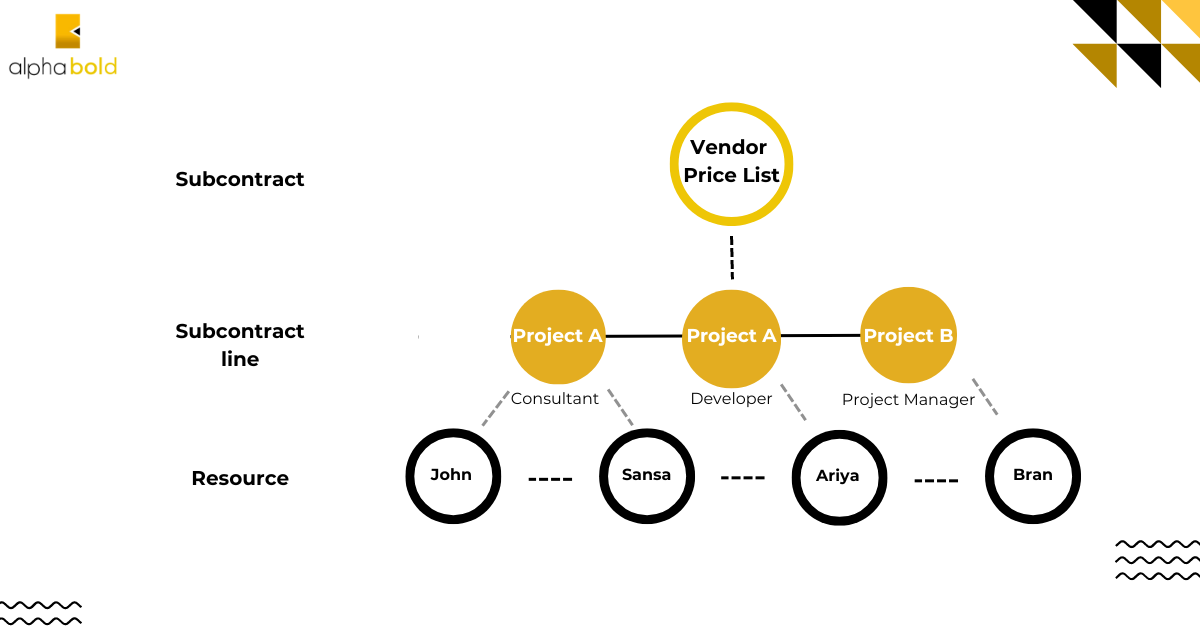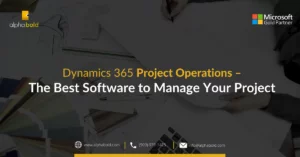Table of Contents
Introduction
This article overviews vendor management in Dynamics 365 Project Operations, including its subcontracting process, key concepts, and functionalities. It gives project managers a deeper understanding of using vendor management software to strengthen supplier relations and cross-collaboration.
As technology grows and projects become more complex, it’s getting increasingly important for project managers to optimize vendor relationships, enhance efficiency, and mitigate potential risks. When outsourcing processes are inefficient, vendor performance is inconsistent, and communication breaks down, it can result in expensive delays and wasted opportunities. According to a survey by the Institute of Supply Management, implementing automated vendor/supplier selection has proven highly effective in reducing purchasing time by up to 50%. This not only leads to significant cost savings but also enhances overall efficiency.
Nobody is immune to the pain of dealing with incomplete or inaccurate vendor performance metrics, manual procedures, or disparate systems. With features that make the selection of vendors, onboarding, and operational monitoring easier, Dynamics 365 Project Operations acts as a powerful vendor management tool that tackles these problems head-on. Such tools can help your company save money on purchases, enhance project results, and establish stronger vendor relationships throughout your project’s lifecycle.
Why Is Vendor Management Important in Today's Business?
Businesses’ ultimate goal is to grow and grab the greatest market share. Therefore, they need a reliable management solution that facilitates vendor collaboration since the number of suppliers and the complexity of the supply chain will likely rise over time.
Conventional HR and procurement procedures are inadequate to address the unique demands of managing an external workforce. Businesses are now turning to cloud-based digital solutions, such as a vendor management system, to stay competitive across borders. Here’s a list of benefits that you can realize by using management software with good vendor management capabilities:
- You can reduce expenses and control budgets by identifying risks and skillfully negotiating for renewals.
- You can minimize the impact of time limits. Automating vendor inspection can help your employees save time and effort by avoiding manual work.
- As a manager, you need to understand all vendor-related data comprehensively. 360 supervision will give your business a holistic view and effectively monitor potential issues or the need for updates and further analysis.
- Vendor management tools will simplify the process of assessing compliance activity, making it easier for managers to ensure adherence to regulations and guidelines.
- Risk assessment and management are crucial for project leaders and managers who must hire new suppliers and develop techniques for managing third-party risks. When a business aims for growth or expansion, a simple, adaptable, and clear vendor process is essential.
Vendor Management Capabilities in Dynamics 365
When it comes to Dynamics 365 vendor management, it not only helps you keep an inventory of suppliers, but it also helps you apply technology to develop an integrated and functional approach that contributes to improved business outcomes.
To ensure that every facet of your supplier relationship is optimized for convenience and affordability, Dynamics 365 incorporates vendor management throughout its Source to Pay process. Hence, this process encompasses everything from procurement to payment.
Dynamics 365 comes with an extensive list of capabilities that can assist you in the administration of your vendors:
- Search for suitable vendors based on product type, location, price, and other parameters.
- Approve vendors who meet the qualifications and establish records for vendors containing all pertinent information.
- Make necessary changes to the vendor’s data, such as altering the payment terms or bank accounts.
- Continuously monitor the vendor’s performance by utilizing various measures, including delivery time, quality, and compliance.
- Facilitating collaboration with suppliers requires using a centralized platform that displays purchase orders, invoices, and consignment stock.
Every business that relies on external suppliers or partners must have a system to manage its vendors. These vendor management capabilities (with some modifications) are available in the following modules within Dynamics 365:
- Dynamics 365 Commerce,
- Dynamics 365 Finance,
- Dynamics 365 Project Operations, and
- Dynamics 365 Supply Chain Management
Note: For this blog, we’ll stick to the vendor collaboration process within Dynamics 365 Project Operations.
Learn Effortless Vendor Management in Dynamics 365 Project Operations
Explore how the Dynamics 365 vendor management system can enhance client relationships and meet business needs with AlphaBOLD.
Request a DemoVendor Collaboration in Microsoft Dynamics 365 Project Operations

This section describes the end-to-end subcontract vendor management procedure in project-based companies. The following diagram illustrates the usual business process flow when you subcontract services. The structure of the process flow looks like this:
- Subcontract creation
- Staffing
- Subcontractors working on project assignments
- Vendor invoice creation and management
Growing businesses often switch to Dynamics 365 for Project Operations. Want to know why? Read our blog: Why Growing Businesses Switch to Dynamics 365 for Project Operations?

Step-By-Step Description of the Vendor Subcontracting Process in Dynamics 365 Project Operations:
Here is a detailed breakdown of the vendor subcontracting process:
- The project manager initiates a subcontract with a supplier, leveraging the price lists linked to the vendor management system. The vendor account is categorized as a vendor or supplier based on its relationship type. Purchases are listed as line items, covering time, expenses, or products, with each subcontract line’s transaction class defining its purpose.
- Project managers or vendors can revise subcontract details, adjusting pricing through the purchase price lists. Vendor contacts are then associated with subcontract lines, ensuring real-time updates. If a bookable resource is unavailable, the system automatically generates one when linking a vendor contact to a subcontract line.

- Each subcontract line follows either a fixed-price or time-and-material invoicing model. Fixed-price lines adhere to milestone-based invoicing schedules. Once finalized, the subcontract is confirmed, but if further modifications are required, it can be reopened for edits, shifting its status from confirmed to draft.
- A generic team member can be assigned to a subcontract line to streamline resource management. These designated team members can be booked directly into projects or through resource scheduling. Subcontractors track their time, expenses, and materials, submitting reports for approval. Vendor-approved timesheets reflect project costs based on contract worker purchase prices or roles.
- Vendor invoices are recorded with detailed line items covering labor, materials, milestones, or fees under a specific project. The system ensures vendor management software accuracy by automatically matching invoices to subcontract lines or projects, using a three-way match verification process to prevent manual errors. After verification, project managers can adjust cost numbers as needed. Once all lines are confirmed, the vendor invoice is marked as “Ready for Payment” and processed through the accounting system, with final costs accurately reflected in the project.

- After completing the verification process, the project manager can analyze the automatic project numbers, remove or add additional project cost numbers, or both.
- Once all lines have been verified, the vendor invoice is marked as “Ready for Payment.” The next step is to get the vendor invoice and associated lines into an accounting or payables system to process payment. The actual expenses incurred by the vendor are entered into the project, overwriting any previously reported project costs.
Key Concepts of Vendor Management in Microsoft Dynamics 365 Project Operations
Before exploring the vendor subcontracting functionality in Microsoft Dynamics 365 Project Operations, it’s important to familiarize yourself with some key concepts. This section provides you with the necessary information to get started.
1. The Contracting Unit:
The contracting unit defines the subcontract with the vendor. Effective communication and coordination between the contracting unit and the subcontractor is crucial for successful project management. The contracting unit is responsible for overseeing the delivery of the eventual project and is typically owned by the division or practice.
2. Purchase Currency:
Within Project Operations, the purchase currency is the specific currency in which the subcontract is generated. Subcontractor costs on a project are typically recorded in this currency. It is important to note that the purchase currency may not always be the same as the project currency. The project currency might be different from the sales currency.
3. Billing Methods:
Projects often involve two common contracting models: fixed-fee and consumption-based. In the context of sales and purchase, Project Operations supports various billing methods. When it comes to purchasing, it’s important to understand how these methods operate within a vendor management tool:
- Time and Material Billing Method: When a subcontract line uses the Time and Material billing method, project costs update as vendors log their time. It’s crucial to match vendor invoices with subcontractor cost transactions for accuracy. Project managers can verify vendor invoices against approved subcontractor hours. Once verified, prior cost actuals are reversed, and new ones are set based on the vendor invoice
- Fixed-Price Billing Method: Vendor invoices are tied to predetermined milestones in the fixed-price contracting model, ensuring clarity and predictability. Subcontractor employees log time for project managers to review and approve before temporary cost actuals are generated. When a vendor invoices for a milestone, project managers verify it against documented costs. After confirmation, the actual costs are adjusted and recorded in the system.
- Project managers can cross-reference previously documented cost actuals with the milestone when the vendor issues an invoice. At the end of the verification process, the actual costs are turned around, and the milestone-based cost is documented.
4. Project Price Lists on Subcontracts:
Project price lists are essential for managers to establish purchase prices for various project-related components, including time and expenses. These lists play an important part in ensuring accurate and efficient cost management. In Project Operations, it is possible to have a few price lists, each with its own date-effective subcontract.
Remember: Dynamics 365 Project Operations doesn’t allow overlapping dates for project price lists, which can create challenges when managing pricing and contracts. The system should be updated to accommodate this functionality, streamline operations, and avoid potential errors.
5. Category of Transactions within Subcontracts:
There are four different kinds of transaction classes that Project Operations supports:
- Time
- Expense
- Material
- Fee
Estimating and incurring purchase costs is limited to Time, Expense, and Material transaction classes. Fee is a transaction class that only generates revenue and does not apply to purchasing.
6. Dimensions of Purchase Pricing:
When setting up ‘Purchase Price’ or ‘Defaulting on time transactions,’ managers can choose which characteristics to utilize with pricing dimensions. Project Operations only allow fixed dimension settings when it comes to purchasing.
Role and Bookable Resources are the two characteristics that help you set up purchase price lists and manage defaulting subcontract lines.
Prepared to Maximize the Achievement of Your Project Goals?
Discover how improved vendor management in Dynamics 365 Project Operations can strengthen stakeholder relationships with AlphaBOLD.
Request a DemoConclusion
This blog explains the vendor collaboration process and functionalities for Vendor Management in Dynamics 365 Project Operations. If you have questions, refer to our blog or Microsoft Learn. This module helps you efficiently manage vendor and agent data and automate tasks like searching and filtering invoices, allowing you to focus on your core business objectives.
If you require assistance with setup or have any concerns regarding the vendor collaboration module in Dynamics 365, our AlphaBOLD Dynamics 365 Consultants team is always prepared to provide the best support.
Explore Recent Blog Posts








